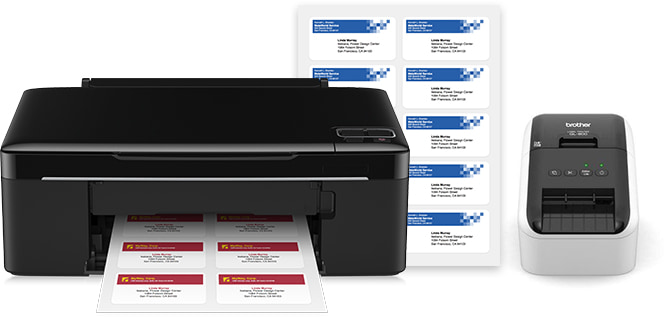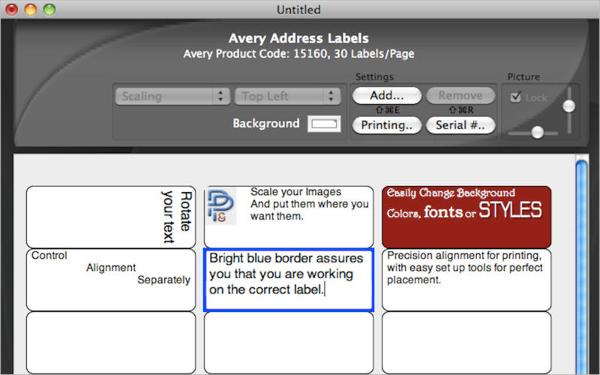Connect a LabelWriter® 450 Twin Turbo to your PC or Mac®. and you’re ready to import data directly from Microsoft® Word, Excel and Google Contacts. Print impressive address, file folder labels, name badges and more without the extra work and hassle of printing sheet labels on a standard desktop printer. DYMO 1755120 LabelWriter 4XL Thermal Label Printer. Dymo label writer is the printer of choice for. ZEBRA Label Printing Software for Mac Easily import spreadsheet data and print barcodes on your ZEBRA printer on your Mac. Label LIVE makes designing and printing labels for ZEBRA printers more intuitive.
- Used Label Printers Machines For Sale
- Best Printer For Label Printing
- Label Printer For Mac Os X
- Label Printers For Manufacturing
- Best Label Printer For Mac
Meet Avery Design & Print Online!

Label Printers Compact and Versatile Brother Label Printers Help Tackle a Variety of Tasks Brother label printers are ideal for office, business, or home needs and can handle a variety of labeling tasks including address labels for packages, envelopes, visitor badges, event identification, product labeling, and more. The Zebra ZD410 label printer connects directly to your Mac computer with a USB cable and allows you to print labels for your items. Setting up your Zebra ZD410 involves the following steps.
Need to create custom printed labels, name tags, or stickers quickly and easily? Avery Design & Print Online is the best way to design and print your own custom labels and more, with no software needed. To get started, just create an Avery.com account, choose the type of product you want to use — from address labels, to stickers, gift tags, and more, select a templated design or create your very own, customize it, upload spreadsheets of data like names and addresses, then print out your artwork! It's that simple. And the best part? It's free!
You can save projects for reuse later, mail merge information so you can create multiple shipping labels in just a few clicks, and even save a PDF of your completed designs. Plus, you can access Avery Design and Print Online from any desktop or mobile device, too.
And remember, Avery products feature Sure Feed technology, which helps prevent printer jams using a unique strip that guides your labels through, saving you time and money. So whatever you create, you won't have to worry about smudges or misprints.
With paper usage having lessened in recent years, the price of printers has dropped dramatically. You can now pick up a decent all-in-one model for less than $50 and a quality laser printer for under $100.
But more things being done digitally doesn’t make printers any less important — physical documents still need to be sent, photos need printing, and many businesses prefer hard copies of invoices. Then there’s the need to print things like concert tickets, shipping labels, and boarding passes.
What we're getting at is that printers aren’t going anywhere any time soon.

In this article, we’re going to walk you through how to put a printer to work. We’ll look at:
- How to connect a printer to your Mac
- How to find a printer IP address on a Mac
- How to print wirelessly from your Mac
Before we get into setting up a printer, though, it’s best if you remove any unused printers from the Mac you're using.
Note: If there no printers previously installed on your system you can skip this next section and jump straight into how to connect a printer.
Removing an unused printer
Only printers that you’ll be using need to be connected to your Mac. Unused printers take up unnecessary space and might conflict with any new device that you install. You can remove a printer manually from within Printers & Scanners or with a tool like CleanMyMac X. The latter is the preferred option but we’ll run you through both methods.
Removing an unused printer manually
Printers can be deleted manually in the following way:
- Go to System Preferences > Printers & Scanners.
- Select the printer from the list and click on the - button.

Removing a printer with CleanMyMac X
While the manual method is straightforward, it does not guarantee that all of the files associated with a printer are removed from your system. Files and documentation can be left behind, taking up space that new printers should be occupying.
CleanMyMac X removes every trace of a printer from your Mac. So, remove a printer from the list in Printers & Scanners, then give CleanMyMac X a run through to rid your computer of any files that are left behind.
The easiest way to do this is with a System Junk clean. This scans your system for broken and outdated files for removal.
- Download CleanMyMac X (for free!).
- Launch the app and select System Junk from the sidebar.
- Hit Scan and wait while CleanMyMac X scans your system.
- Hit Clean.
You’re all done and ready to add a fresh printer to your system.
How to connect a printer to your Mac
How you connect a printer to your Mac really depends on what kind of printer you’re using. If the printer is a newer model there’s every chance that it supports AirPrint, in which case you can be set up and printing in moments. If not, you’ll need the printer drivers, which you’ll have to find on your system or download from the Web.
How to add a Wi-Fi printer
Before you can set up a printer on your Mac you’ll need to connect it to the Wi-Fi network. If the printer has a built-in display, use this to enter the name and password of the Wi-Fi network (you’ll find these details on the bottom of your main router).
If the printer uses Wi-Fi Protected Setup (WPS), you’ll need to refer to the router’s documentation for details on how a WPS printer can be added. If the router is an AirPort Base Station, follow these instructions from Apple:
1. Open AirPort Utility, which is in the Utilities folder of your Applications folder.
2. Select your base station in AirPort Utility, then enter the base station password, if prompted.

3. From the menu bar, choose Base Station > Add WPS Printer.
4. Select either 'First attempt' or 'PIN' as the type of WPS connection to allow. Then click Continue.
If you selected 'First attempt,' push the WPS button on the printer. When the printer's MAC Address appears in AirPort Utility, click Done.
If you selected 'PIN,' enter the printer's PIN number, which should be listed in the printer's documentation. Then click Continue. When the printer's MAC Address appears in AirPort Utility, click Done.
5. Quit AirPort Utility.
Once your printer is hooked up to the Wi-Fi, connecting it to your Mac is easy:
- Go to System Preferences > Printers & Scanners, then click the + button at the bottom of the list.
- Leave the Default tab selected and let your Mac search for printers connected to the WiFi network.
- Click on your printer from the list. If the printer supports AirPrint it will show opposite Use.
- Click on Add Now.
If the printer doesn’t support AirPrint, you’ll need to install the necessary drivers.
- Click on the name of the printer in the list.
- Click Add to download the drivers from Apple’s servers.
- Click Add again to add the printer.
If the drivers you need aren’t available on Apple’s servers you’ll need to download them from the manufacturer’s website. Once installed, you’ll be able to add the printer from the Printers & Scanners window.
How to add a network printer
Used Label Printers Machines For Sale
You can add a network printer in the same way that you add a wireless printer. If the printer is connected by Ethernet or Wi-Fi your Mac will make it available to add from the Default tab in Printers & Scanners.
If there isn’t an Ethernet or Wi-Fi option, connect the printer to a Mac on the network or directly into the router via USB and add it from Printers & Scanners that way.
How to find a printer IP address on a Mac
Best Printer For Label Printing
If a printer doesn’t show up in the Default tab of Printers & Scanners you might have to connect it via the IP tab. To do this you’ll need to find the printer IP address.
The IP can be found by going to any networked Mac that is configured to the printer and using the Bonjour Browser. This should be enabled by default in Safari. If not, you can enable it by going to Preferences > Advanced and select either “Include Bonjour in the Bookmarks menu” or “Include Bonjour in the Favourites bar.”
You can also open up the Safari browser and go to http://localhost:631/printers/ to see a list of all printers.
Once you have the IP, enter it in the Address field in the IP tab in Printers & Scanners. Give the printer a name, select the printer from the drop-down list, then click Add.

How to print wirelessly from your Mac
Label Printer For Mac Os X
To start printing to a wireless printer you’ll need to configure the printer settings. You can do this by going to System Preferences > Printers & Scanners and clicking on the printer from the list. From here, you’ll be able to set the printer as default and choose the paper size.
To print, simply go to File > Print or press Command+P. Choose your printer from the pop-up menu and configure the number of copies and specific pages.
Label Printers For Manufacturing
Hitting the Print button will send your prints to the print queue, which automatically go to the printer. By going to System Preferences > Printers & Scanners and selecting your printer, you can open the print queue and pause, resume, or delete jobs. Here is where you can also keep an eye on ink levels.
Top Tip: Before going all in with a multiple page print, test your printer by creating a test document in TextEdit.
Such is the simplicity of Mac that adding and removing printers and performing printing tasks is a straightforward task. But remember: when removing a printer from your system, use CleanMyMac X to ensure all files linked to the printer are completely removed from your system to avoid conflict. CleanMyMac X is a leading Mac utility tool developed to help you rid your system of old and outdated files in a few clicks.
Best Label Printer For Mac
These might also interest you:
